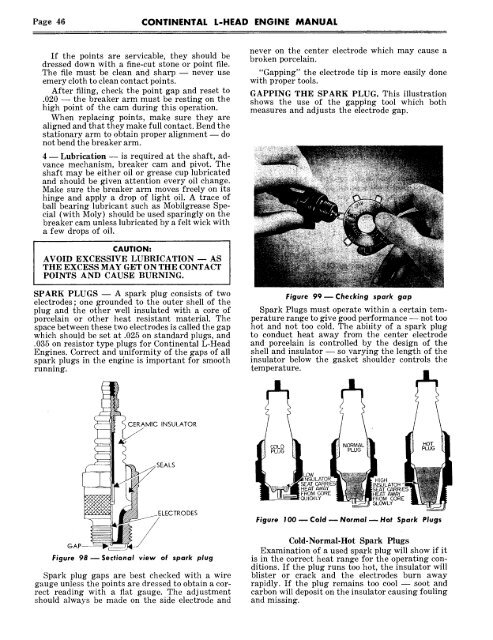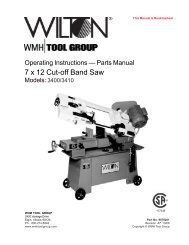Continental L-Head Overhaul Manual - Igor Chudov
Continental L-Head Overhaul Manual - Igor Chudov
Continental L-Head Overhaul Manual - Igor Chudov
Create successful ePaper yourself
Turn your PDF publications into a flip-book with our unique Google optimized e-Paper software.
Page 46 CONTINENTAL L-HEAD ENGINE MANUAL<br />
If the points are servicable, they should be<br />
dressed down with a fine-cut stone or point file.<br />
The file must be clean and sharp -- never use<br />
emery cloth to clean contact points.<br />
After filing, check the point gap and reset to<br />
.020 -- the breaker arm must be resting on the<br />
high point of the cam during this operation.<br />
When replacing points, make sure they are<br />
aligned and that they make full contact. Bend the<br />
stationary arm to obtain proper alignment -- do<br />
not bend the breaker arm.<br />
4 -- Lubrication -- is required at the shaft, advance<br />
mechanism, breaker cam and pivot. The<br />
shaft may be either oil or grease cup lubricated<br />
and should be given attention every oil change.<br />
Make sure the breaker arm moves freely on its<br />
hinge and apply a drop of light oil. A trace of<br />
ball bearing lubricant such as Mobilgrease Special<br />
(with Moly) should be used sparingly on the<br />
breaker cam unless lubricated by a felt wick with<br />
a few drops of oil.<br />
CAUTION:<br />
AVOID EXCESSIVE LUBRICATION -- AS<br />
THE EXCESS MAY GET ON THE CONTACT<br />
POINTS AND CAUSE BURNING.<br />
SPARK PLUGS -- A spark plug consists of two<br />
electrodes; one grounded to the outer shell of the<br />
plug and the other well insulated with a core of<br />
porcelain or other heat resistant material. The<br />
space between these two electrodes is called the gap<br />
which should be set at .025 on standard plugs, and<br />
.035 on resistor type plugs for <strong>Continental</strong> L-<strong>Head</strong><br />
Engines. Correct and uniformity of the gaps of all<br />
spark plugs in the engine is important for smooth<br />
running.<br />
GAP--<br />
CERAMIC INSULATOR<br />
~ -SEALS<br />
LECTRODES<br />
Figure 98 ~ Sectional view of spark plug<br />
Spark plug gaps are best checked with a wire<br />
gauge unless the points are dressed to obtain a correct<br />
reading with a flat gauge. The adjustment<br />
should always be made on the side electrode and<br />
never on the center electrode which may cause a<br />
broken porcelain.<br />
"Gapping" the electrode tip is more easily done<br />
with proper tools.<br />
GAPPING THE SPARK PLUG. This illustration<br />
shows the use of the gapping tool which both<br />
measures and adjusts the electrode gap.<br />
Figure 9Om Checking spark gap<br />
Spark Plugs must operate within a certain temperature<br />
range to give good performance -- not too<br />
hot and not too cold. The abidty of a spark plug<br />
to conduct heat away from the center electrode<br />
and porcelain is controlled by the design of the<br />
shell and insulator -- so varying the length of the<br />
insulator below the gasket shoulder controls the<br />
temperature.<br />
COLD<br />
PLUG<br />
HEAT AWAY<br />
FROM OORE HEAT AWAY<br />
FROM CORE<br />
SLOWLY<br />
Figure 100 ~ Cold ~ Normal ~ Hot Spark Plugs<br />
Cold-Normal-Hot Spark Plugs<br />
Examination of a used spark plug will show if it<br />
is in the correct heat range for the operating conditions.<br />
If the plug runs too hot, the insulator will<br />
blister or crack and the electrodes burn away<br />
rapidly. If the plug remains too cool -- soot and<br />
carbon will deposit on the insulator causing fouling<br />
and missing.
















